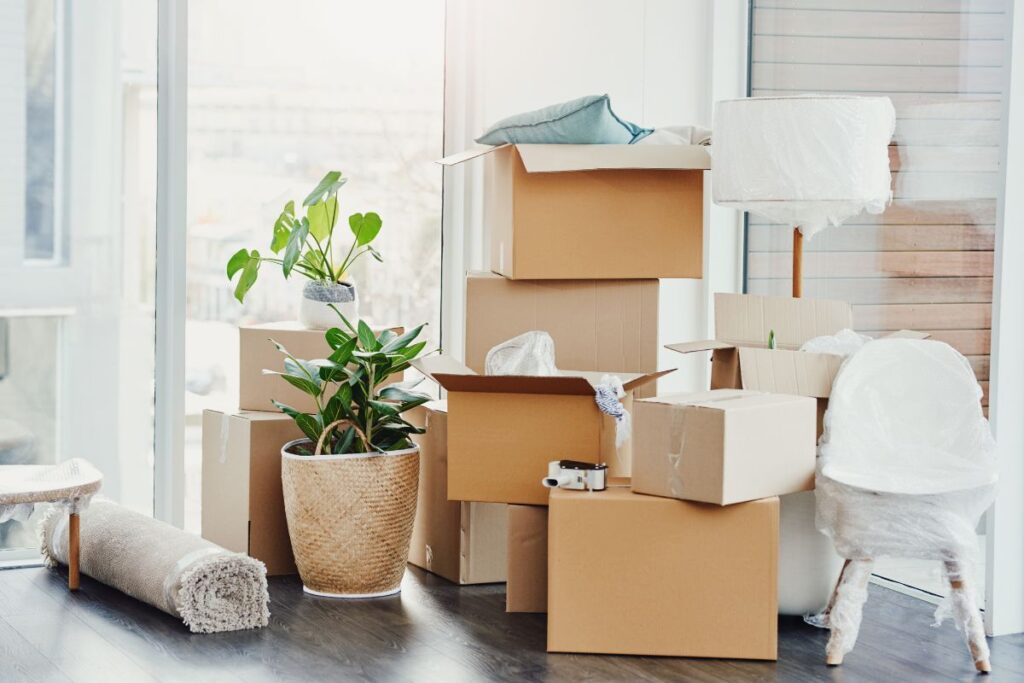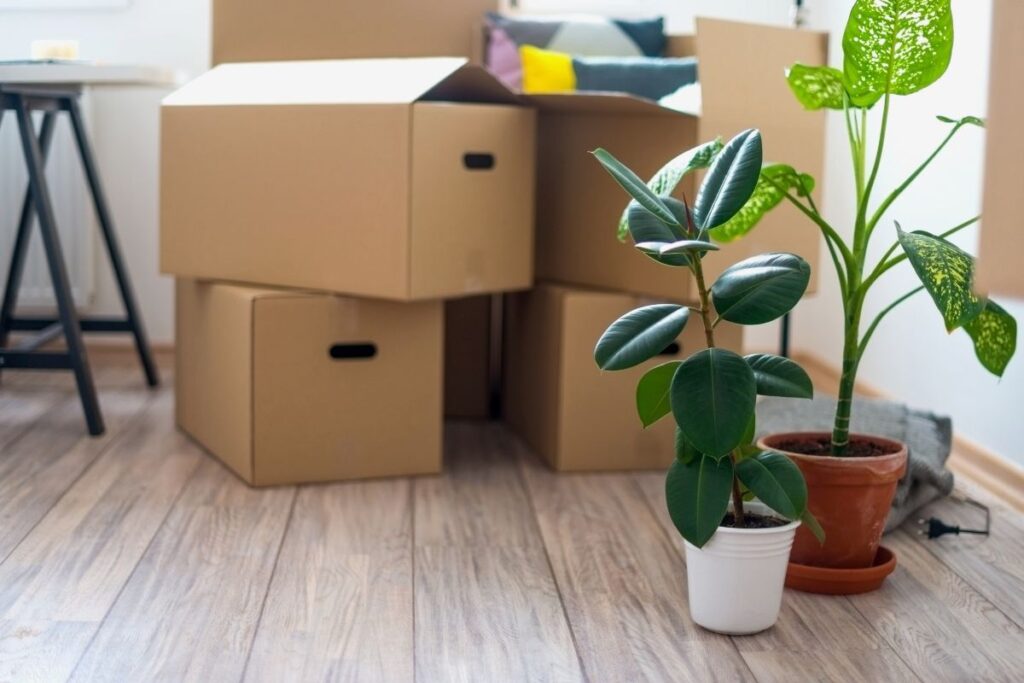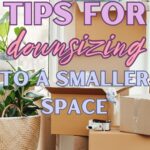Inside: Use these tips if you’re downsizing to a smaller space. They will help to ease the transition to your new home.
Moving into a smaller space can be a refreshing change, but it isn’t without challenges.
One of the biggest ones you’ll face? Figuring out how to downsize your personal belongings.
After all, you can’t fit the same amount of stuff you’ve always owned into a smaller space – at least, not without feeling totally overwhelmed and surrounded by clutter.
And you certainly don’t want to move in with all of that extra stuff. That can instantly make your new space feel crowded and unwelcoming.
Instead, you’ll want to tackle the task of decluttering as much as you’re able before you move.
While it might feel daunting initially, decluttering before you downsize your home doesn’t have to be too difficult.
Instead, with a little planning and a thoughtful approach to the challenge, you can set yourself up for success – and say goodbye to unneeded stuff before settling into your new space.

Why People Are Downsizing to a Smaller Space
There are a variety of reasons that people would downsize their space. Here are some of the most common ones.
Empty Nesters
Once all of your kids have moved out of your home, you have different space needs than when you were raising children. Perhaps you want less square footage to manage and a home that better suits your current life stage.
Moving to a Care Facility
Sometimes the needs of a loved one extend beyond the care that can be provided by family members so they move to a care facility. This can be by choice or necessity depending on the situation.
Desire to Live More Simply
Some people opt to downsize to a smaller space to save money and enjoy the benefits of living more simply. Perhaps there are other goals at play such as an interest in traveling as you’d rather spend the extra money you’d have used on housing to fund travel adventures instead.
Relocating
Sometimes a new job will take you to a new city or even a different country to live in. Relocating to a new place could mean downsizing depending on the cost of living and the options in your new location.
Season of Transition
A season of transition in your life could also mean downsizing. Perhaps you need to stay with family members for a time or live in a smaller apartment. This can be one of few instances where it may make sense to rent a storage unit temporarily until you get settled in a more permanent home.
No matter what the reason is for why you’re downsizing to a smaller space, these six tips can help to ease the transition.

6 Decluttering Tips for Downsizing to a Smaller Space
Ready to roll up your sleeves and make some progress when it comes to downsizing your stuff? Keep these tips in mind as you navigate the process to stay organized, prevent overwhelm, and achieve your decluttering goals.
1. Understand your space limitations before you begin.
If possible, assess your new space before you start decluttering to know what you’re working with.
How many closets will you have – and how will you use them? Will you have a garage? An attic?
Will you need to explore furniture that doubles as storage space to accommodate some of the stuff you’ll need to keep?
How many cabinets are in the kitchen – and how does that compare to what you’re working with today?
By knowing just how much you need to cut before you make your move, you’ll be able to set clear, attainable goals and trust that you’ll be in a good position to keep your new space clutter-free.

2. Give yourself plenty of time.
Don’t save your decluttering project for the weekend before your big move. Instead, I recommend starting the process as soon as you’ve made your decision to downsize – even if it’s months or even years ahead of your actual move date.
The more you can organize and declutter before a move the easier the process will be.
Trying to rush the task of decluttering will leave you stressed out and overwhelmed, and you’ll be forced to make decisions about certain items without having the time to think it through.
By starting the process as early as possible, you can take a slower, more methodical approach to decluttering. You can tackle each space in your home one by one instead of attempting to do it all at once.
You can find ways to donate unneeded items that will actually benefit those in need throughout your community.
Need extra cash? Starting early will give you plenty of time to post them on an online marketplace, bring them to a consignment shop, or plan a garage sale.

3. Be ruthless.
If you struggle to get rid of stuff you no longer need, it’s time to learn how to let it go.
If you’re in the process of moving into a smaller space, you simply can’t keep all of the things in your current space. There isn’t enough room.
You don’t want to end up with too much stuff and not enough space.
Instead, you’ll need to be ruthless in decluttering the junk that’s accumulated in your home over the years. Try to refrain from holding onto more than you need otherwise, you’ll find yourself overwhelmed and disorganized when you’re done.
Ask yourself – do I really need to keep this? What purpose is this item serving? What value does it add? And if you don’t have good answers to those questions, you should probably part ways.
Use these decluttering questions to help bring clarity to whether or not something should stay or go.

4. Get rid of duplicate items.
One of the easiest ways to cut down on clutter when you’re downsizing? Get rid of duplicate items throughout your house.
Now, don’t take this too literally. There are plenty of things you need multiples of – bath towels, dishes, t-shirts.
But there are certain spaces in your home where you probably have lots of duplicates that you may not need to keep.
The kitchen is one of the biggest culprits here. How many baking pans do you own – and how many do you truly need? Do you have pots and pans taking up space that you could get rid of?
The linen closet is another spot that tends to accumulate duplicate stuff. Do you need that many spare sheets? That much extra bedding? All of those extra pillows?
Figure out if you truly need them or not. In many cases, you can let some of them go – without even noticing that they are gone.

5. Get rid of stuff you never use.
This one might feel a bit obvious, but many of us are holding onto things that we never actually use – and truly don’t need.
Think about your closet. Do you actually wear all of the clothes in there? Or are there shirts, pants, or dresses that you’ve held onto for years without actually putting them on? What about your shoe collection, or those winter coats?
Use these tips to get ruthless with cleaning out your clothing.
That’s just one example. Chances are, you can find plenty of other things at home that you haven’t used in a long time – and will likely never use again.
Old books, spare electronics, the jumbled mess of cables and plugs you’re saving just in case. It’s time to get realistic with those someday and what-if items.
Much of it has likely become clutter that you can let go of.

6. Convert physical items to digital keepsakes.
When you’re living in a big space with plenty of storage, it’s easy to accumulate souvenirs, keepsakes, and mementos. All of us have sentimental items that we want to hold onto – even though we know we won’t actually use them.
But when you’re downsizing to a smaller living space, room for storage is at a premium. And when it comes down to it, it might not make sense to hold onto all of those nostalgic items.
Instead, consider preserving some of those physical keepsakes in digital format. A great example? Photos.
If you’re holding onto multiple albums and boxes of old pictures, you might want to scan them and save them electronically. Not only will this let you save some space, but it’ll ensure the quality of those photos is preserved forever, as they’ll deteriorate over time
You can also get creative when it comes to saving other physical clutter as digital keepsakes.
Holding onto old souvenirs? Record a video of them while you share a memory about why they’re special.
Keeping a box of old notes or letters? Scan them and save them as electronic documents. Since technology can fail, it’s a good idea to have a backup system (or two) in place.
While you might not want to part with everything, you might be surprised to see how much physical clutter you can convert to digital memories without losing the sentimental value.

Final Thoughts on Downsizing to a Smaller Space
Are you considering downsizing? It can feel like a big step, but also one that can have many benefits.
If you’re planning to downsize in the future starting to prepare for it now by proactively decluttering your things will help make that move easier.
Then you can enjoy your new space with the items that you love and actually use.
What’s your favorite tip for downsizing to a smaller space? Share it in the comments section below.
Sign up on the form below to get weekly decluttering tips sent straight to your inbox. You’ll also get the free Your Home Decluttered Jumpstart which includes 100 easy items to declutter and 12 high-impact areas to declutter in 10 minutes.


I really needed to hear these things today!
Thank you for the work you do.
Always remember that your laptop/computer can crash and you could loose all photos so put them also on flash drive or in ? iCloud
Very true. I updated the post to add that recommendation.
When we were married I moved into my new husband’s 12′ x 60′ mobile home. Worked out fine. Three children later, we were definitely crowded. I dealt with ALL of our possessions every 6 months by pretending we were going to move. This mind game made it a bit easier to deal with getting rid of our stuff down to a pile we could deal with.–Anne
This is a brilliant tip, thank you!
Way back in my life: i fell in love with the Pacific Northwest, but I was 2500 miles away, in Ohio! I managed to go to grad school in Oregon…1978 and decided to move with my wife! Packed everything we wanted to keep for our new life, into a VW van, without any job prospects… we embarked…
Now: both happily retired still living in Paradise.
What would we take today, to…
My one big question I ask myself when trying to decide to let go of something that has accumulated in my house is “When I look at it, does it make me smile?”. If it does, then I keep it and if it doesn’t or makes me feel overwhelmed, then it has to go. Of course, there are other ones, but that is my main onel
I have taken pictures of things and then create a small photo book through an app that gives a free photo book each month (I just have to pay shipping). Then I have the memories but the book takes up minimal room.
did you just throw the photographs in the trash? this is where I get stuck. I digitize them then can’t seem to just throw them away……
If the photos are likely to be of interest to family or friends, offer them the chance to take a few. I made the rounds of family reunions and gatherings with a folder full of photos I no longer wanted, and there were always people who wanted a few.
Some photos were easy to discard, though. Duplicates, groups of people who mostly had their backs to the camera, scenery that we no longer recognized, duplicates of photos, etc.
Lots can be gotten rid of by just tossing them, but there are a bunch worth offering to others.
I often end up with power plugs of various voltage levels for dog clippers or power drills ect. Impossible to read those numbers on the plug.
I had over 40 years of joirnals and calendars that I had been keeping. while I was downsizing (4 times in as many years) I realized one of the best questions was ” do I want my family and friends dealing with this when I die. I was amazed how many times I said “no” or … no one else needs to see this! I took 20 years of journals and calendars to the shredders. I felt so relieved! I have gone from a two bedroom with an office to a small studio in the last 10 years. FREEDOM!